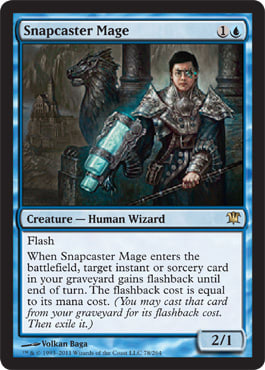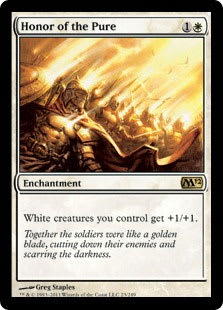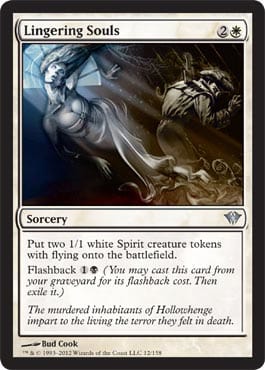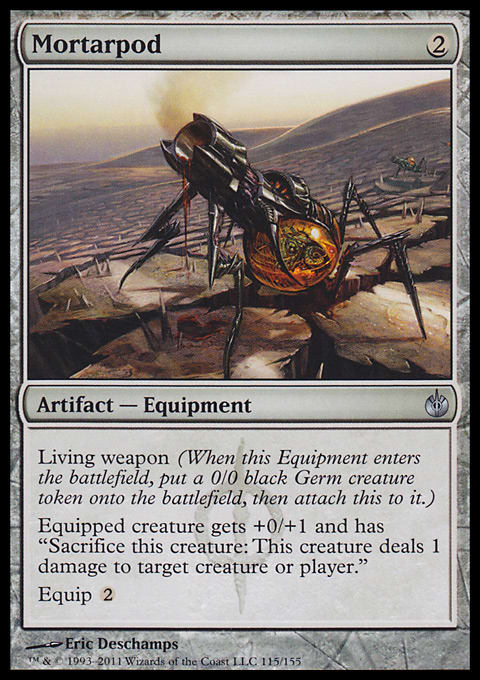On our recent trip to Grand Prix: Nashville, my girlfriend Rada decided that it was time for her to start becoming a Standard player. For the past few years, Rada has been exclusively a Limited player, kicking butt in Drafts and Sealed events, but sitting out for Constructed events. Now she just needed a deck to get started with.
Here’s the problem, though: Unless you have unlimited financial resources, how do you get into Standard without spending two years drafting and trading for the cards you might need? In Rada’s case, she spent some time researching the Standard metagame in an effort to determine what deck she could acquire that would meet the following requirements:
- A deck that would be suited to her play style and that she would enjoy playing.
- A deck with a learning curve that didn’t just play itself . . . so that playing it would help her develop her Standard chops.
- A proven deck that she could actually win tournaments with.
Her research led her to choose a version of Mage-Blade. She brought some rares with her to the GP for trading, and over the course of the weekend, she acquired the cards she needed for the decklist she was trying to build. The problem with this plan was that even with doing some trading, she ended up spending over $400 at the dealer’s tables to acquire the cards for her deck. After doing some testing, she wanted to make some changes, so she needed to buy even more cards. The good news is that the first time she played it was at a competitive Friday Night Magic tournament, where she won the whole thing without losing a match.
While this approach might work for many people, I was horrified at the amount of money required for the startup costs. Besides, what if she wants to play a different deck now? I decided there must be a cheaper way to get into Standard and still be successful. Since it was the idea of spending hundreds of dollars on a deck that bothered me, I chose $100 as the budget cap for my deck.
I figured that the key to success was to choose a deck without any mythic rares in it. The bad news about the secondary market is that mythic rare prices have soared into the stratosphere. Pretty much all of the ones seeing play in Standard seem to be selling for at least $20, and many go for well over $40 each. The good news about this is that the price of other rares has deflated to a quite reasonable level.
The next question was: What deck could I win with that doesn’t use or need mythic rares? Haunted Humans uses cards like Hero of Bladehold, Sword of War and Peace, and Angelic Destiny. Mage-Blade uses Geist of Saint Traft, Snapcaster Mage, and Sword of War and Peace. Wolf Run uses Primeval Titan, Inferno Titan, Huntmaster of the Fells, Thrun, the Last Troll, and Garruk, Primal Hunter. Naya Pod uses Elesh Norn, Grand Cenobite, Huntmaster of the Fells, Inferno Titan, and Wurmcoil Engine. U/B control uses Grave Titan, Snapcaster Mage, Consecrated Sphinx, Batterskull, Karn Liberated, Wurmcoil Engine and Sorin Markov. Even Zombie decks are using cards like Phyrexian Obliterator and Liliana of the Veil.
Most Standard decks seem to spend $200 or more on just mythic rares, and that doesn’t even cover the other rares or the uncommons. Clearly, there is a reason so many people are playing and winning with these decks. These are strong decks with good synergy that pack a lot of powerful cards. Their mythic rares are obviously an important part of their formula for success or players probably wouldn’t be shelling out hundreds of dollars for them.
So, that meant I needed to design something new—or at least design a version of an existing deck that didn’t really need mythic rares to be successful. One of the things that the cards mentioned above seem to have in common is that they’re almost all late-game cards—a lot of planeswalkers and 6-mana creatures. Even the ones that cost the least mana, Snapcaster Mage and Sword of War and Peace, aren’t early-game cards, and they use more mana than their casting costs would suggest.
The first thing I determined was that I wanted to make an aggressive deck that didn’t use late-game cards in order to help ensure I didn’t end up on the wrong side of a late-game arms race. Mono-green is both not my style and lacking in the kinds of non-mythic tools to handle the current environment. As a result, I focused my attention on red aggro, white aggro, blue aggro, and black aggro. After making lists for all four, I decided to focus on the white deck. This was for several reasons.
- It was the deck that, every time I looked at the list, I didn’t start thinking about all of the mythic rares it so badly needed to make it better. Many of my lists looked as though I was just blatantly sacrificing the power level of the deck in order to avoid playing with mythic rares.
- It was similar in style to many of the decks that I’ve played recently, which should give me an advantage when I’m playing it.
- It had very strong synergy and took advantage of some of the best things about the current pool of cards in Standard.
- It was fast and adaptable, and it had strong sideboard options.
The first thing I decided to do was determine what the must-have rares were for the deck since those would be the biggest hit to my $100 budget cap. I decided that there were two rares an aggressive white deck couldn’t do without: Honor of the Pure and Champion of the Parish.
$2.50 × 4 = $10
$4.50 × 4 = $18
Running total: $28 (8 cards)
While this was more than 25% of my cap space, I was doing great—basic lands, commons, and uncommons for my maindeck would probably use up less than 25% of my budget. The commons and uncommons I most wanted were:
$.25 × 4 = $1
$.25 × 4 = $1
$.25 × 4 = $1
$1 × 4 = $4
$2 × 4 = $8
$.50 × 4 = $2
$1 × 4 = $4
Running total: $49 (36 cards)
At this point, I’d used half my budget on thirty-six cards. I was going to need a total of seventy-five cards (60 maindeck cards + 15 sideboard cards). Given that I probably didn’t need any more rares and I’d be using mostly basic land, I was in great shape. If I just added twenty-four basic lands at $.10 each at this point, I’d still have almost $50 to spend on my sideboard. The good news was that it meant I could consider whether the deck needed a few more rares to optimize it. The conclusion I came to was that since I could splash some black mana for Lingering Souls without hurting my mana base, I wouldn’t be maxing out the power level of the deck if I didn’t.
$8.50 × 4 = $32
Running total: $81 (40 cards)
Since this deck doesn’t need twenty-four lands, I slipped in one more rare that was a great fit for the deck:
$3.50
$.10 × 17 = $1.70
$.10 × 2 = $.20
Running total: $86.40 (60 cards)
This left me with just $13.60 for my sideboard, which basically meant I needed to avoid rares. The first couple times I played the deck, I actually had mostly basic lands in my sideboard—I wanted to determine what the deck’s sideboard needs were before buying cards for the sideboard. Of course, if you are part of a good enough group of playtesters, you can always try proxying decks up and testing them before deciding what to spend your money on.
I was very happy with how the deck performed in almost every matchup. The deck’s biggest weakness seemed to be against decks that were either running over-the-top amounts of mass removal or were at least able to sideboard in copious amounts of it. As a result, I decided battling mass removal would be the main focus of my sideboard.
$1 × 4 = $4
$.25 × 4 = $1
Running total: $91.40 (68 cards)
I also decided that Revoke Existence was important because Ratchet Bomb, Curse of Death's Hold, and Sword of War and Peace were all really good against me, and I wanted to be able to save my Oblivion Rings for other uses when possible. While I wasn’t really worried about my matchup with other aggressive decks, I decided to use my last few spots addressing them—just in case. This was also in part because Timely Reinforcements and Mortarpod just synergize so well with my deck.
Revoke Existence
$.25 × 4 = $1
$2 × 2 = $4
$.25
Total cost: $96.65
I played this deck in the FNM that Rada won. In the first round, I beat a Wolf Run deck 2–0. In the second round, I beat a U/B Zombie deck 2–0. Unfortunately, I was paired against Rada in the third round of Swiss.
The match went to three games, and I lost 2–1. In both of the games I lost, I stalled on two lands for several turns with a grip full of 3-mana spells. I was running twenty-two lands at the time (I was maindecking a twenty-five-cent Mortarpod), and I have since gone up to twenty-three lands. This meant I needed a win in the fourth round of Swiss to make the cut for the Top 4, and unfortunately, I lost 2–1 to just miss the cut. Once again, I lost two games in which I was stalled at two lands for multiple turns.
The important thing I was able to determine was that a good player could walk into a game store with $100 and be able to be a force to be reckoned with in a competitive tournament. I manhandled two decks that were much more expensive than mine before losing a super-close match to Rada’s $400-plus deck and then 2–1 to another expensive deck. Both of my losses were close enough that they could easily have gone the other way (especially had I been playing twenty-three lands!) I’ll keep at it, and I’ll let you know if I have any more breakthroughs on winning for 100.

























